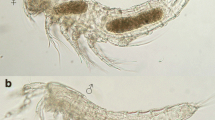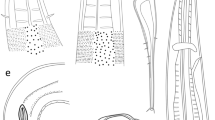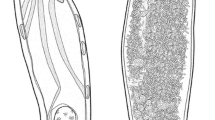Abstract
Ptilocrinus amezianeae n. sp. is a new species of stalked crinoid attributed to the family Hyocrinidae. Forty-five specimens were collected from seamounts north of the Ross Sea, and one specimen from the Kerguelen Plateau at depths ranging from 450 to 1,680 m. The collection from Admiralty and Scott seamounts constitutes the first example of a hyocrinid population known both from in situ photographs and from numerous collected specimens ranging from small juvenile to large adult. Variation in theca and stalk articulation characters throughout ontogeny is congruent with the molecular data and indicates that all the specimens examined belong to a single species. Tegmen and pinnule architecture, brachial arrangement, and stalk articular facets indicate that Ptilocrinus amezianeae n. sp. has close affinities with P. clarki and P. pinnatus from the northeastern Pacific and displays the most derived characters among these three species. Two cases of true arm division into two unequal branches suggest that Ptilocrinus and Calamocrinus are closely related. The picture and video transects on Admiralty seamount show a patchy distribution of living specimens with patches of mean density ca. 2.6 individuals m-2. In situ photographs also document predation by a sea urchin and a sea star on tegmen and proximal arms. The COI gene sequences analyzed in 25 specimens from Admiralty and Scott seamounts display low pairwise distances, low nucleotidic diversity, and intermediate haplotype diversity. These results, together with disarticulated ossicles and attachment disks observed on in situ photographs, indicate that the population investigated here is in decline.








Similar content being viewed by others
Abbreviations
- CAML:
-
Census of Antarctic Marine Life
- IPY:
-
International Polar Year
- NIWA:
-
National Institute of Water and Atmospheric Research
- MNHN:
-
Muséum national d’Histoire naturelle
- CCDB:
-
Canadian Center for DNA Barcoding
- Guelph:
-
Biodiversity Institute of Ontario
References
Améziane N, Roux M (1997) Biodiversity and historical biogeography of stalked crinoids (Echinodermata) in the deep sea. Biodivers Conserv 6:1557–1570. doi:10.1023/A:1018370620870
Améziane N, Roux M (2005) Environmental control versus phylogenic fingerprint in ontogeny: the example of the development of the stalk in the genus Guillecrinus (stalked crinoids, Echinodermata). J Nat Hist 39(30):2815–2860. doi:10.1080/00222930500060595
Améziane N, Roux M (2011) Stalked crinoids from Southern Tasmanian seamounts. Part 1: family Hyocrinidae. J Nat Hist 45:137–170. doi:10.1080/00222933.2010.520825
Aronson RB, Blake DB, Oji T (1997) Retrograde community structure in the late Eocene of Antarctica. Geology 25(10):903–906. doi:10.1130/0091-7613(1997)025<0903:RCSITL>2.3.CO;2
Avise JC (2000) Phylogeography: the history and formation of species. Harvard University Press, Cambridge
Bather FA (1908) Ptilocrinus antarcticus n. sp.: a crinoid dredged by the Belgian Antarctic Expedition. Bull Acad R Sci Belg 3:296–299
Baumiller TK (2008) Crinoid ecological morphology. Ann Rev Earth and Pl Sc 36:221–249. doi:10.1146/annurev.earth.36.031207.124116
Baumiller TK, Mooi R, Messing CG (2008) Urchins in the meadow: paleobiological and evolutionary implications of cidaroid predation on crinoids. Paleobiology 34(1):22–34. doi:10.1666/07031.1
Baumiller TK, Salamon MA, Gorzelak P, Mooi R, Messing CG, Gahn FJ (2010) Post-Paleozoic crinoid radiation in response to benthic predation preceded the Mesozoic marine revolution. Proc Natl Acad Sci USA 107(13):5893–5896. doi:10.1073/pnas.0914199107
Bowden DA, Schiaparelli S, Clark MR, Rickard GJ (2011) A lost world? Archaic crinoid-dominated assemblages on an Antarctic seamount. Deep-Sea Res Pt II 58:119–127. doi:10.1016/j.dsr2.2010.09.006
Conan G, Roux M, Sibuet M (1981) A photographic survey of a population of the stalked crinoid Diplocrinus (Annacrinus) wyvillethomsoni (Echinodermata) from the bathyal slope of the Bay of Biscay. Deep-Sea Res 28(5):441–453. doi:10.1016/0198-0149(81)90136-9
David J, Roux M, Messing CG, Améziane N (2006) Revision of the pentacrinid stalked crinoids of the genus Endoxocrinus (Echinodermata, Crinoidea), with a study of environmental control of characters and its consequences for taxonomy. Zootaxa 1156:1–50
Folmer O, Black M, Hoeh W, Lutz R, Vrijenhoek R (1994) DNA primers for amplification of mitochondrial cytochrome c oxidase subunit I from diverse metazoan invertebrates. Mol Mar Biol Biotechnol 3(5):294–299
Fujita T, Otha S, Oji T (1987) Photographic observations of the stalked crinoids Metacrinus rotundus Carpenter in Suruga Bay, Central Japan. J Oceanogr 43(6):333–343. doi:10.1007/BF02109286
Genin A, Dayton PK, Lonsdale PF, Spiess FN (1986) Corals on seamounts provide evidence of current acceleration over deep-sea topography. Nature 322:59–61. doi:10.1038/322059a0
Gorzelak P, Salamon MA (2009) Signs of benthic predation on late Jurassic stalked crinoids, preliminary data. Palaios 24:70–73. doi:10.2110/palo.2008.p08-032r
Gutt J, Barratt I, Domack E, d’Udekem d’Acoz C, Dimmler W, Grémare A., Heilmayer O, Isla E, Janussen D, Jorgensen E, Kock K-H, Lehnert LS, López-Gonzáles P, Langner S, Linse K, Manjón-Cabeza ME, Meißner M, Montiel A, Raes M, Robert H, Rose A, Schepisi ES, Saucède T, Scheidat M, Schenke HW, Seiler J, Smith C (2011). Biodiversity change after climate-induced ice-shelf collapse in the Antarctic. Deep-Sea Res Pt II. doi:10.1016/j.dsr2.2010.05.024
Ivanova NV, Dewaard JR, Hebert PDN (2006) An inexpensive, automation-friendly protocol for recovering high-quality DNA. Mol Ecol Resour 6(4):998–1002. doi:10.1111/j.1471-8286.2006.01428.x
John DD (1937) Zoology: Crinoidea. Expédition antarctique belge. Résultats du voyage de la Belgica en 1897–99 sous le commandement de A de Gerlache de Gomery. Rapport scientifique, JE Bushmann, Anvers, pp 1–11
Kaufmann, RS, Wilson RR Jr. (1991) A summary and bibliography of seamount biota. Scripps Institution Oceanographic Reference. Series 91–8. La Jolla
Librado P, Rosas J (2009) DnaSP v5: a software for comprehensive analysis of DNA polymorphism data. Bioinformatics 25:1451–1452
Macurda DB, Meyer DL (1974) Feeding posture of modern stalked crinoids. Nature 247:394–396
Messing CG (1985) Submersible observations of deep-water crinoid assemblages in the tropical western Atlantic Ocean. In: Keegan BF, O’Connor BDS (eds) Echinodermata. Balkema, Rotterdam, pp 185–193
Messing CG (1994) Crinoid meadows of the West Indies: distribution, response to flow, disarticulation, sediment production and taphonomy. In: David B, Guille A, Feral JP, Roux M (eds) Echinoderms through Time. Balkema, Rotterdam, p 245
Meyer DL (1985) Evolutionary implications of predation on Recent comatulid crinoids from the Great Barrier Reef. Paleobiology 11(2):154–164
Mironov AN, Sorokina OA (1998) Sea lilies of the order Hyocrinida (Echinodermata, Crinoidea). Zoologicheskie Issledovania 2:1–117
Oji T (1996) Is predation intensity reduced with increasing depth? Evidence from the West Atlantic stalked crinoid Endoxocrinus parrae (Gervais) and implications for the Mesozoic marine revolution. Paleobiology 22(3):339–351
Oji T, Ogawa Y, Hunter AW, Kitazawa K (2009) Discovery of dense aggregations of stalked crinoids in Izu-Ogasawa trench, Japan. Zool Sci 26(6):406–408
Roux M (1980) Les crinoïdes pédonculés (Echinodermes) photographiés sur les dorsales océaniques de l’Atlantique et du Pacifique. Implications biogéographiques. CR Acad Sc Paris, série D 291:901–904
Roux M (1985) Les crinoïdes pédonculés (Echinodermes) de l’Atlantique N.E.: inventaire, écologie et biogéographie. In: Laubier L, Monniot C (eds) Peuplements profonds du Golfe de Gascogne: campagne BIOGAS. Ifremer, Brest, pp 479–489
Roux M (1987) Evolutionary ecology and biogeography of recent stalked crinoids as a model for the fossil record. In: Jangoux M, Lawrence JM (eds) Echinoderm studiesvolume 2. Balkema, Rotterdam, pp 1–53
Roux M (1994) The CALSUB cruise on the bathyal slopes off New Caledonia. In: Crosnier A (ed) Résultat des campagnes MUSORSTOM, vol 12. Memoir Mus Natl Hist 161:9–47
Roux M (2002) Two new species of the genus Thalassocrinus (Echinodermata: Crinoidea: Hyocrinidae) from the Pacific Ocean. Species Divers 7(2):173–186
Roux M (2004) New hyocrinid crinoids (Echinodermata) from submersible investigations in the Pacific Ocean. Pac Sci 58(4):597–613
Roux M, Bohn JM (2010) Revision of the genus Gephyrocrinus Kœhler and Bather, 1902 (Echinodermata, Crinoidea, Hyocrinidae). Zoosystema 32(3):425–437
Roux M, Lambert P (2011) Two new species of stalked crinoids from the north-eastern Pacific in the genera Gephyrocrinus and Ptilocrinus (Echinodermata, Crinoidea, Hyocrinidae). Effects of ontogeny and variability on hyocrinid taxonomy. Zootaxa 2825:1–54
Roux M, Pawson DL (1999) Two new Pacific Ocean species of hyocrinid crinoids (Echinodermata), with comments on presumed giant-dwarf gradients related to seamounts and abyssal plains. Pac Sci 53(3):289–298
Roux M, Messing CG, Améziane N (2002) Artificial keys to the genera of living stalked crinoids (Echinodermata). B Mar Sci 70(3):799–830
Schneider JA (1988) Frequency of arm regeneration of comatulid crinoids in relation to life habit. In: Burke RD, Mladenov PV, Lambert P, Parsley RL (eds) Echinoderm biology. Balkema, Rotterdam, pp 531–538
Shortis MR, Seager JW, Williams A, Baker BA, Sherlock M (2007) A towed body stereo-video system for deep water benthic habitat surveys. In: Grun A, Kahmen H (eds) 8th Conference on optical 3-D measurement techniques. ETH Zurich, Zurich, pp 150–157
Tamura K, Dudley J, Nei M, Kumar S (2007) MEGA4: Molecular evolutionary genetics analysis (MEGA) software version 4.0. Mol Biol Evol 24:1596–1599
Ward RD, Holmes BH, O’Hara TD (2008) DNA bar coding discriminates echinoderm species. Mol Ecol Resour 8:1202–1211
Wilson RR, Kaufmann RS (1987) Seamount biota and biogeography. In: Keating B, Fryer P, Baleza R, Boehlert G (eds) Seamount. Islands and Atolls. American geophysical union, Washington, DC, pp 355–377
Acknowledgments
Specimens, data, and photographs of P. amezianeae n. sp. were collected by and made available through the New Zealand International Polar Year-Census of Antarctic Marine Life Project (NZ IPY-CAML project IPY2007-01). We thank Kareen Schnabel, Sadie Mills and Owen Anderson at NIWA, Rick Webster at the Museum of New Zealand Te Papa Tongarewa, Fabien Aubert and Nicolas Gasco through the TAAF administration for providing specimens. The SEM were done using the JEOL 840A at the Plateforme de Microscopie Electronique of the Muséum national d’Histoire naturelle. We thank the ANTFLOCKS project funded by the French national research agency (“ANR”; USAR n°07-BLAN-0213-01). Funding parties also include the Département des Milieux et Peuplements Aquatiques at the Muséum national d’Histoire naturelle in Paris, the Museum Victoria in Melbourne, Australia (travel grant to ME and LH), NIWA in Wellington, New Zealand (travel grant to ME) and the French Polar Institute IPEV (travel grant to ME and LH). DB was funded under NZ IPY-CAML project IPY2007-01. We also thank Pr Fran Ramil of the Departamento de Ecoloxia e Bioloxia Animal, Facultade de Ciencias do Mar, Universidade de Vigo, España.
Author information
Authors and Affiliations
Corresponding author
Rights and permissions
About this article
Cite this article
Eléaume, M., Hemery, L.G., Bowden, D.A. et al. A large new species of the genus Ptilocrinus (Echinodermata, Crinoidea, Hyocrinidae) from Antarctic seamounts. Polar Biol 34, 1385–1397 (2011). https://doi.org/10.1007/s00300-011-0993-2
Received:
Revised:
Accepted:
Published:
Issue Date:
DOI: https://doi.org/10.1007/s00300-011-0993-2




